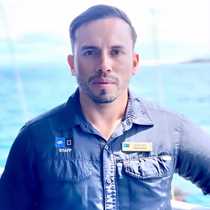Santa Cruz Island
Early in the morning we had a dry landing at the Pier of Puerto Ayora, the largest town in Galápagos situated on the island of Santa Cruz. We soon took a bus ride towards the Charles Darwin Research Station where we got to learn about the projects the Galápagos National Park is using to eradicate introduced animals and conserve the endemic flora and fauna of this archipelago. This was a very interesting place where we could see giant tortoises from different islands and learn about the captive breeding programs to increase the survival rate of the hatchlings.
It was fascinating to see Lonesome George, the last of his kind and the last specimen from Pinta Island to our current knowledge. In fact we were pretty lucky to find him very active and moving around. We’ll see what this individual does in the future to keep the species alive.
For lunch we went on a bus ride to the highlands of Santa Cruz Island, passing many vegetation zones as we went up in altitude. At the end we entered the humid zone where we stopped at a beautiful restaurant for lunch and rest.
The afternoon had people going in many directions; some of us went to see giant tortoises in the wild, a very nice change of color from the very pale coastline we have been visiting up until now. It was a green landscape full of endemic giants feeding on grass and some of them even cooling off in the rainwater ponds, sharing the ponds with some white cheeked pintail ducks and common stilts as well.
The Pit Craters also known as “twin holes “(collapse of the magma chamber) were another afternoon destination. This area holds the milky forest made out of Scalecia pedunculata (endemic genus and species) the tallest of the Scalecia species and one of the best examples of insular gigantism. Further into the milky forest we were able to learn about finches. We even spotted several species of these small brown land birds, so important to evolutionary thought.
At the end of the day, we came back to town with a very different view of the islands. We had visited the home of the endemic giants of the archipelago, a very green and high paradise where the fit have survived. We understand that we are the ones responsible to keep pristine places like this in our world.




